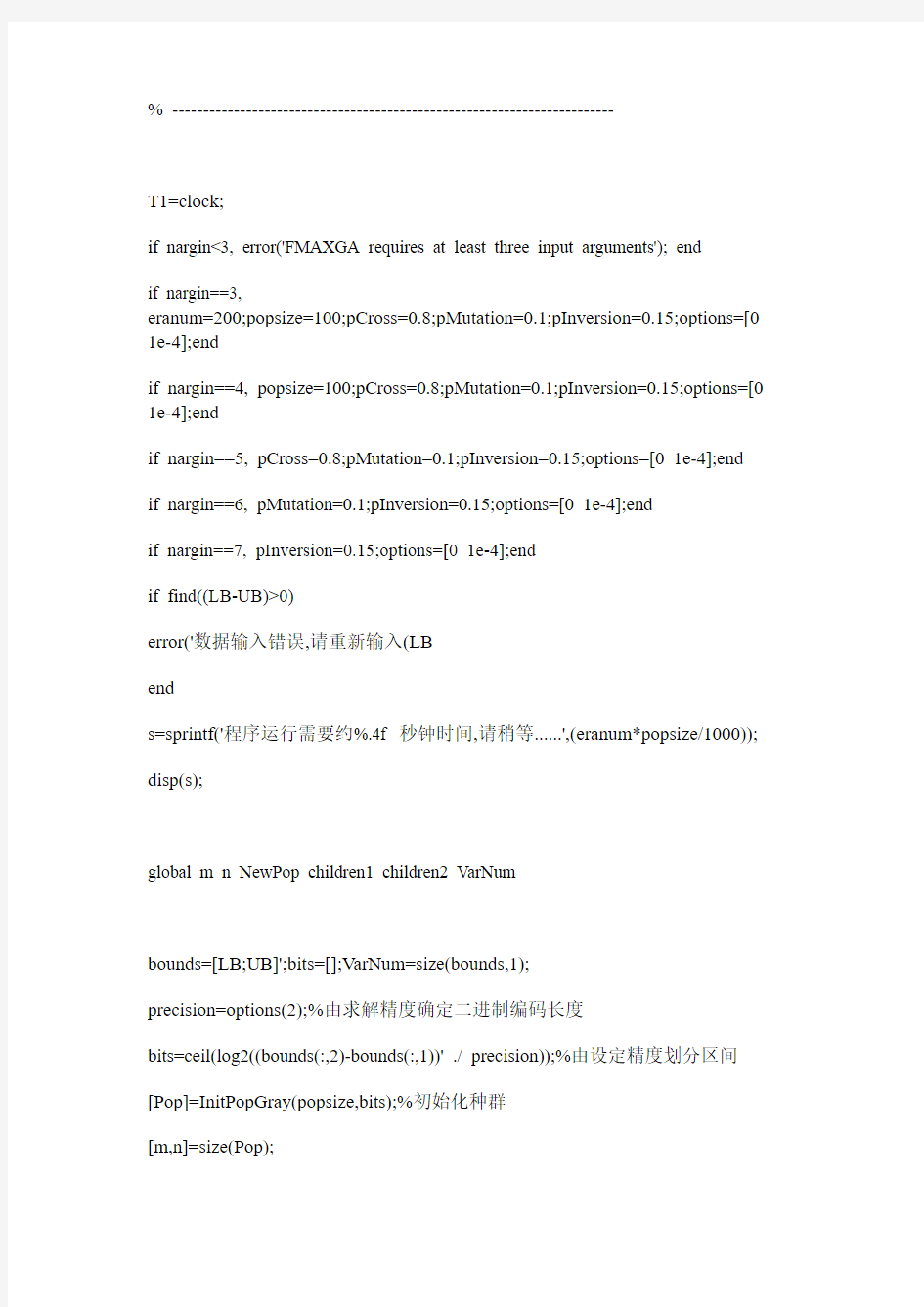三个遗传算法程序【精品毕业设计】(完整版)


遗传算法程序(一):
说明: fga.m 为遗传算法的主程序; 采用二进制Gray编码,采用基于轮盘赌法的非线性排名选择, 均匀交叉,变异操作,而且还引入了倒位操作!
function
[BestPop,Trace]=fga(FUN,LB,UB,eranum,popsize,pCross,pMutation,pInversion,opti ons)
% [BestPop,Trace]=fmaxga(FUN,LB,UB,eranum,popsize,pcross,pmutation)
% Finds a maximum of a function of several variables.
% fmaxga solves problems of the form:
% max F(X) subject to: LB <= X <= UB
% BestPop - 最优的群体即为最优的染色体群
% Trace - 最佳染色体所对应的目标函数值
% FUN - 目标函数
% LB - 自变量下限
% UB - 自变量上限
% eranum - 种群的代数,取100--1000(默认200)
% popsize - 每一代种群的规模;此可取50--200(默认100)
% pcross - 交叉概率,一般取0.5--0.85之间较好(默认0.8)
% pmutation - 初始变异概率,一般取0.05-0.2之间较好(默认0.1)
% pInversion - 倒位概率,一般取0.05
0.3之间较好(默认0.2)
% options - 1*2矩阵,options(1)=0二进制编码(默认0),option(1)~=0十进制编
%码,option(2)设定求解精度(默认1e-4)
%
% ------------------------------------------------------------------------
T1=clock;
if nargin<3, error('FMAXGA requires at least three input arguments'); end
if nargin==3,
eranum=200;popsize=100;pCross=0.8;pMutation=0.1;pInversion=0.15;options=[0 1e-4];end
if nargin==4, popsize=100;pCross=0.8;pMutation=0.1;pInversion=0.15;options=[0 1e-4];end
if nargin==5, pCross=0.8;pMutation=0.1;pInversion=0.15;options=[0 1e-4];end
if nargin==6, pMutation=0.1;pInversion=0.15;options=[0 1e-4];end
if nargin==7, pInversion=0.15;options=[0 1e-4];end
if find((LB-UB)>0)
error('数据输入错误,请重新输入(LB end s=sprintf('程序运行需要约%.4f 秒钟时间,请稍等......',(eranum*popsize/1000)); disp(s); global m n NewPop children1 children2 VarNum bounds=[LB;UB]';bits=[];VarNum=size(bounds,1); precision=options(2);%由求解精度确定二进制编码长度 bits=ceil(log2((bounds(:,2)-bounds(:,1))' ./ precision));%由设定精度划分区间[Pop]=InitPopGray(popsize,bits);%初始化种群 [m,n]=size(Pop); NewPop=zeros(m,n); children1=zeros(1,n); children2=zeros(1,n); pm0=pMutation; BestPop=zeros(eranum,n);%分配初始解空间BestPop,Trace Trace=zeros(eranum,length(bits)+1); i=1; while i<=eranum for j=1:m value(j)=feval(FUN(1,:),(b2f(Pop(j,:),bounds,bits)));%计算适应度 end [MaxValue,Index]=max(value); BestPop(i,:)=Pop(Index,:); Trace(i,1)=MaxValue; Trace(i,(2:length(bits)+1))=b2f(BestPop(i,:),bounds,bits); [selectpop]=NonlinearRankSelect(FUN,Pop,bounds,bits);%非线性排名选择[CrossOverPop]=CrossOver(selectpop,pCross,round(unidrnd(eranum-i)/eranum)); %采用多点交叉和均匀交叉,且逐步增大均匀交叉的概率 %round(unidrnd(eranum-i)/eranum) [MutationPop]=Mutation(CrossOverPop,pMutation,VarNum);%变异[InversionPop]=Inversion(MutationPop,pInversion);%倒位 Pop=InversionPop;%更新 pMutation=pm0+(i^4)*(pCross/3-pm0)/(eranum^4); %随着种群向前进化,逐步增大变异率至1/2交叉率 p(i)=pMutation; i=i+1; end t=1:eranum; plot(t,Trace(:,1)'); title('函数优化的遗传算法');xlabel('进化世代数(eranum)');ylabel('每一代最优适应度(maxfitness)'); [MaxFval,I]=max(Trace(:,1)); X=Trace(I,(2:length(bits)+1)); hold on; plot(I,MaxFval,'*'); text(I+5,MaxFval,['FMAX=' num2str(MaxFval)]); str1=sprintf ('进化到%d 代,自变量为%s 时,得本次求解的最优值%f\n对应染色体是:%s',I,num2str(X),MaxFval,num2str(BestPop(I,:))); disp(str1); %figure(2);plot(t,p);%绘制变异值增大过程 T2=clock; elapsed_time=T2-T1; if elapsed_time(6)<0 elapsed_time(6)=elapsed_time(6)+60; elapsed_time(5)=elapsed_time(5)-1; end if elapsed_time(5)<0 elapsed_time(5)=elapsed_time(5)+60;elapsed_time(4)=elapsed_time(4)-1; end %像这种程序当然不考虑运行上小时啦 str2=sprintf('程序运行耗时%d 小时%d 分钟%.4f 秒 ',elapsed_time(4),elapsed_time(5),elapsed_time(6)); disp(str2); %初始化种群 %采用二进制Gray编码,其目的是为了克服二进制编码的Hamming悬崖缺点function [initpop]=InitPopGray(popsize,bits) len=sum(bits); initpop=zeros(popsize,len);%The whole zero encoding individual for i=2:popsize-1 pop=round(rand(1,len)); pop=mod(([0 pop]+[pop 0]),2); %i=1时,b(1)=a(1);i>1时,b(i)=mod(a(i-1)+a(i),2) %其中原二进制串:a(1)a(2)...a(n),Gray串:b(1)b(2)...b(n) initpop(i,:)=pop(1:end-1); end initpop(popsize,:)=ones(1,len);%The whole one encoding individual %解码 function [fval] = b2f(bval,bounds,bits) % fval - 表征各变量的十进制数
